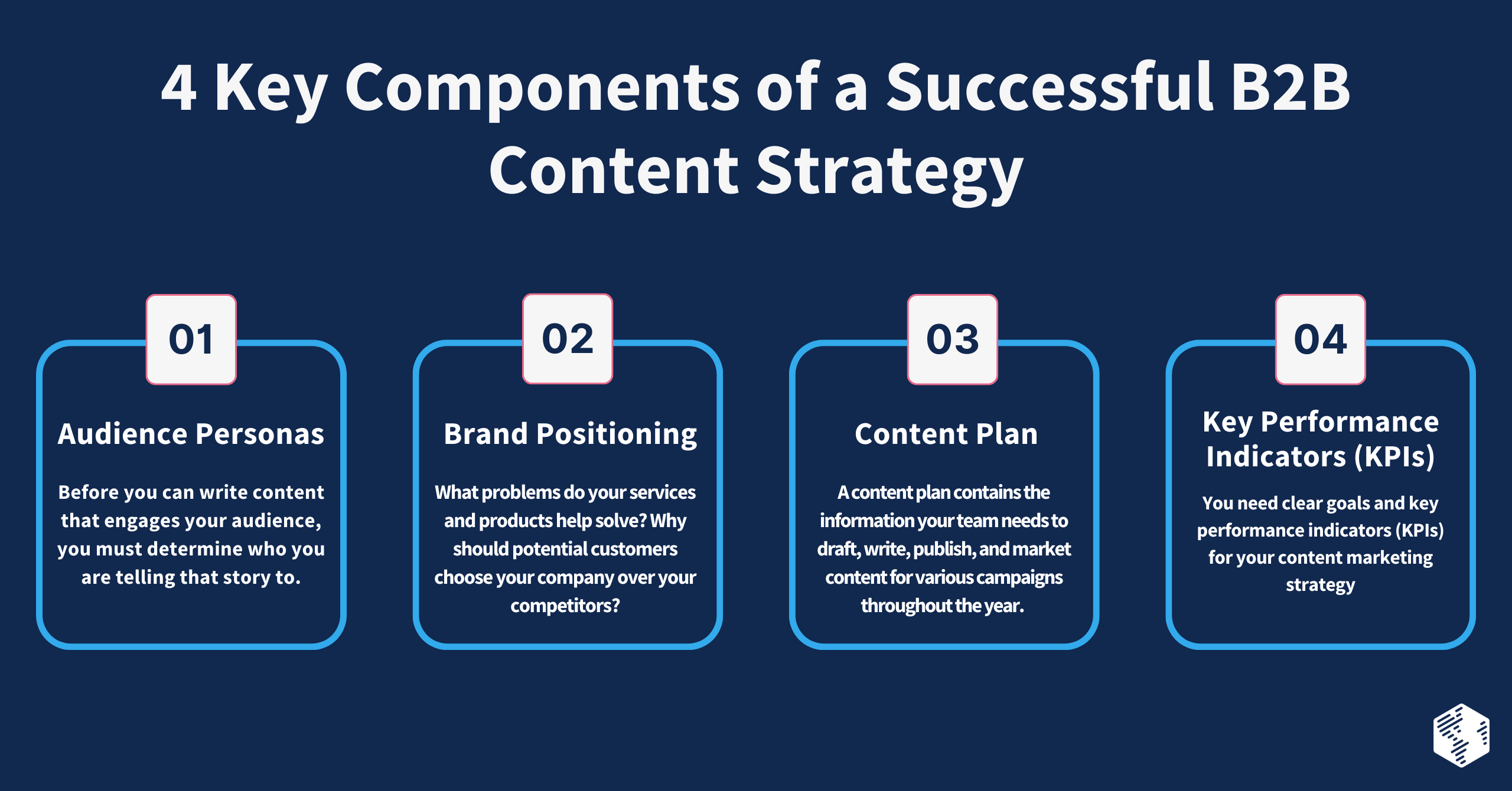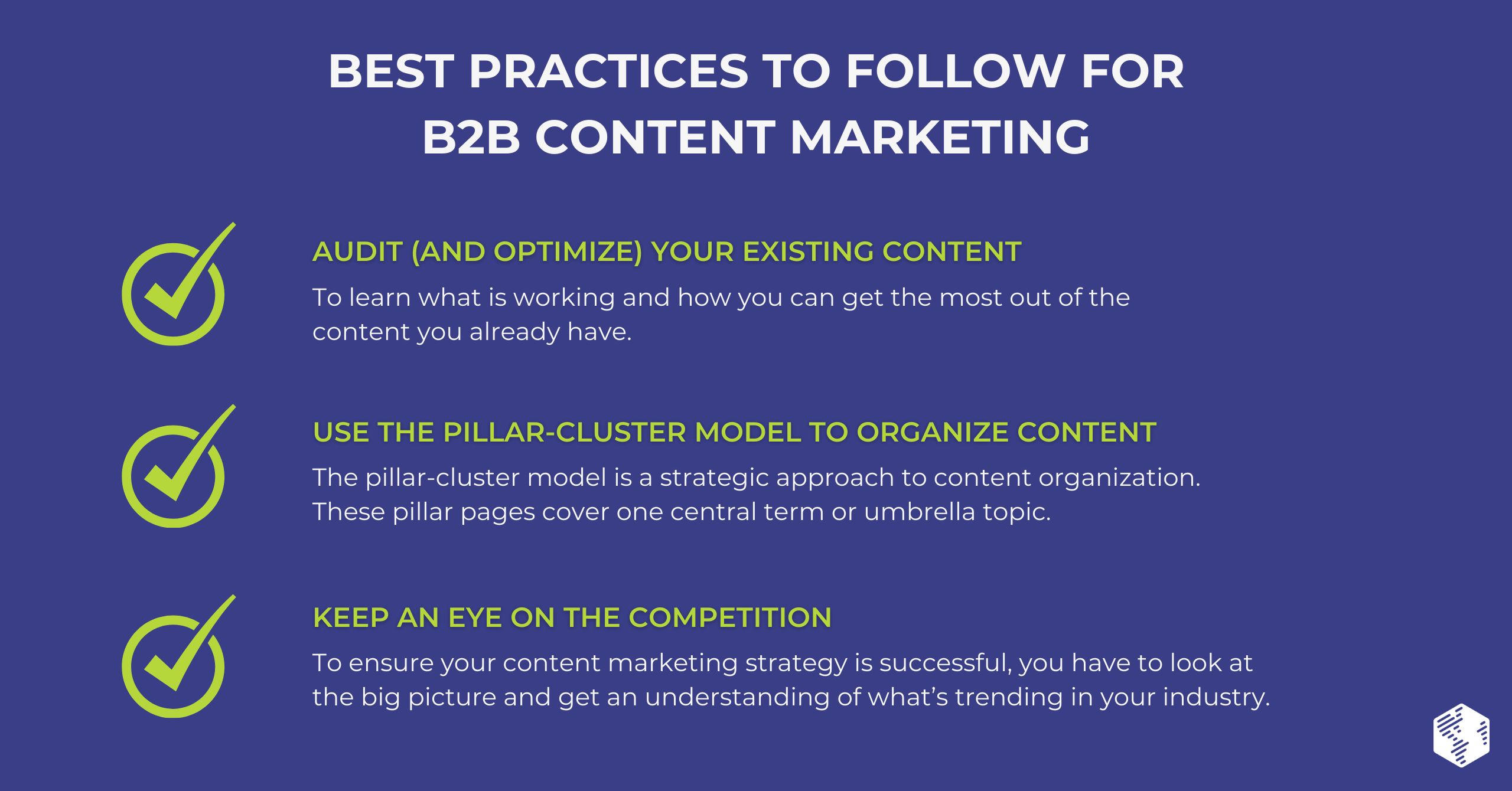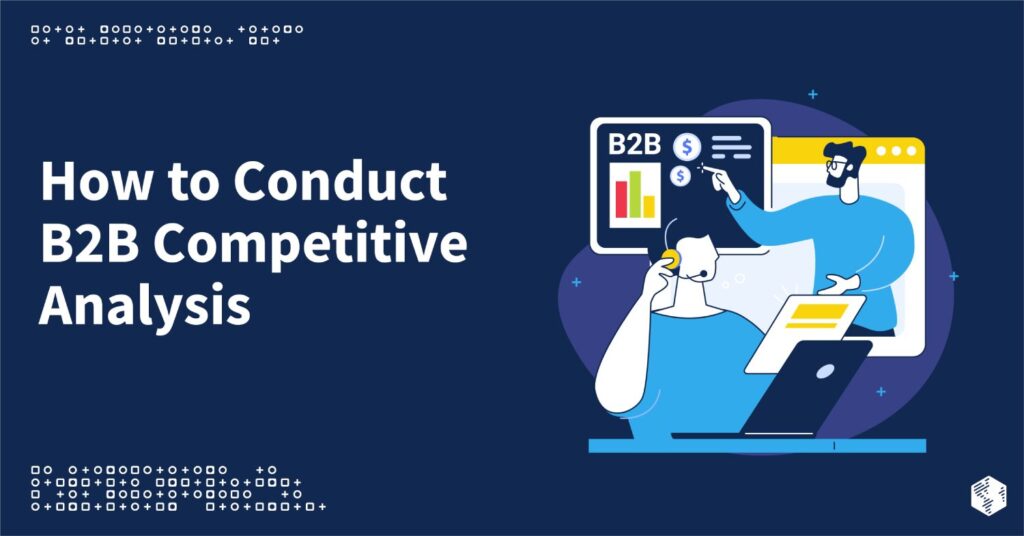You’ve heard it before, and we’ll say it again: Content is king.
Content is one of the most effective ways to boost brand awareness, reach new audiences, and encourage buyers to make a purchasing decision.
But simply publishing videos, blogs, social media posts, and landing pages isn’t enough. If you want your business-to-business (B2B) company to stay competitive and gain the revenue-generating benefits of content marketing, you have to develop and implement a strategy.
We’ve created this guide to content marketing best practices, tips, and tricks to help you transform into an expert content strategist.
Are you ready? Let’s dive in.
What Is a B2B Content Marketing Strategy?
A B2B content marketing strategy is a high-level plan to create, publish, and distribute content in a variety of formats that engages with and nurtures a target audience. In the B2B space, the purpose of successful content marketing is to demonstrate subject matter expertise in the industry, increase brand awareness, deliver valuable content, and resolve the pain points of prospective customers.
Using a diverse range of content formats, B2B marketers strategically publish digital content with the aim to attract, inform, entertain, educate, and convert buyers into qualified leads.
Why B2B Companies Need a Content Marketing Strategy
Content marketing is an invaluable part of any B2B company’s overall marketing strategy.
There’s a significant difference between chaotically publishing content and building a data-driven, organized, efficient content system with specific goals and metrics—but when it’s done right, content marketing adds value to your audience, builds trust in your organization, and helps you generate more traffic and leads.
Here are a few of the benefits of creating, documenting, and implementing a B2B content marketing strategy.
Content Marketing Builds Trust in Your Brand
When you consistently and strategically share high-quality content, you establish your B2B company as an authoritative, trustworthy source—which makes your audience more likely to buy from your brand.
The more you engage with your customers through content, the more they will trust your brand, your products, and your services—and the easier it is to convert prospects into customers.
Content Marketing Increases Organic Website Traffic
Websites that produce engaging, informative, authoritative content are ranked higher on the results pages of search engines such as Google. That means your content will be seen by more people and is therefore more likely to get in front of the eyes of potential customers.
Content should inform, entertain, and engage buyers, as well as solve their problems. When your content provides value to your audience, you will see an increase in organic website traffic.
Content Marketing Has an Unlimited Potential ROI
A content marketing strategy focusing on high-quality, valuable, optimized content is an affordable and cost-effective marketing technique. It is the most effective way to connect with your audience and creates scalable, long-lasting results.
Unlike other types of marketing, each piece of content can be updated, and recycled over and over at a fraction of its original cost. Over time, as you continue to refurbish and repurpose old content in new ways, the process becomes cheaper in the long run.
Content marketing consistently performs better and more reliably than other marketing tactics. The return on investment (ROI) B2B companies can gain from content marketing makes it one of the most important and cost-effective foundations of marketing success.
4 Key Components of a Successful B2B Content Strategy
A successful B2B content marketing strategy will likely include four elements: audience personas, brand positioning, a content plan, and goals.
These components are key to developing a content strategy that will fit the unique needs and objectives of your B2B company. Consider each element as you work to build your organization’s marketing approach.
Audience Personas
Before you can write content that engages your audience and tells the story of your brand, you must determine who you are telling that story to. Once you have an audience in mind, you can create content that solves their problems, fits their needs, and answers their questions.
Consider surveying your existing customer base, figuring out who your competitors are selling to, and researching industry trends to define your audience—as well as who you don’t want to target. Then, create audience personas based on your ideal customers.
These personas will guide every step of your content marketing strategy.
Brand Positioning
What makes your B2B brand unique? What problems do your services and products help solve? Why should potential customers choose your company over your competitors?
The answers to these questions are the foundation of your brand’s message, voice, and story.
Brand positioning—how your brand is positioned in the minds of buyers—should be clearly defined and consistent across all your content marketing channels. Your company’s brand will shape your content marketing strategy, from the topics you focus on to the language you use.
Every piece of content should enforce the brand positioning of your B2B organization.
Content Plan
After you have identified your audience and defined your brand, you can create a content plan.
A content plan contains the information your team needs to draft, write, publish, and market content for various campaigns throughout the year. Include the content formats you want to focus on, the topics you want to cover, and the channels you want to use to distribute published pieces.
The objective of your content plan should align with the overall marketing and revenue goals of your organization. Think about how each piece will affect your customers and contribute overall growth.
Key Performance Indicators (KPIs)
If you don’t establish clear goals and key performance indicators (KPIs) for your content marketing strategy, you won’t know what’s working—or what’s not working—which makes it difficult to know which marketing campaigns to invest in further.
Content marketing KPIs may include metrics like the organic traffic or revenue generated by a piece of content, how many times it was shared on social media, the number of leads attributed to it, or how well it ranks on search engine results pages (SERPs).
Identify the KPIs that matter most to your B2B company, determine what success looks like when it comes to content, and make sure each piece of content has a clear, measurable goal.
Best Practices to Follow for B2B Content Marketing
Every B2B company is different, and so is every content marketing strategy. That means your company can’t just copy what your competitors do; instead, you have to develop a unique content marketing strategy that fits the long-term goals of your organization.
Fortunately, there are a few content marketing best practices that the most successful strategies all take into account. Follow these tips to build a successful B2B content strategy.
Audit (and Optimize) Your Existing Content
Put your existing content to work by conducting a content audit—the process of reviewing, analyzing, updating, and optimizing your existing content—to learn what is working and how you can get the most out of the content you already have.
Content audits give you the opportunity to understand what resonates with your audience, generate more organic traffic, boost engagement, and save resources.
If you take the time to improve old content, you can use it again and again.
Use the Pillar-Cluster Model to Organize Content
The pillar-cluster model is a strategic approach to content organization.
It starts with pillar pages. These pillar pages cover one central term or umbrella topic. Topic clusters are sets of pages with inter-related content that support the pillar page.
Using internal linking, you can connect topic cluster pages together and to the pillar page to both indicate their relationship to search engines like Google and make it easy for website visitors to navigate your content.
Keep an Eye on the Competition
To ensure your content marketing strategy is successful, you have to look at the big picture and get an understanding of what’s trending in your industry.
Start by researching your competitors using a variety of SEO tools:
- What content formats are they using?
- Who is their target audience?
- What topics do they cover?
- What keywords are they ranking for?
The answers to these questions will help you determine what works well for your competitors and give you an idea of how you can succeed in your niche.
Design Content for Every Stage of the Buyer’s Journey
Your content marketing strategy must engage customers at all stages of the buyer’s journey.
Content at each level has a different purpose:
- Awareness: Content that helps buyers understand their problem
- Consideration: Content that informs buyers about the way to solve their problem
- Decision: Content that shows buyers why your company is the best choice to address their problem
- Delight: Content that creates an outstanding customer experience
Every piece of content needs a well-defined goal. What stage of the buyer’s journey is it intended for? The needs of your audience will determine how to approach the content.
Organize Your Content Plan with an Editorial Calendar
A content calendar is the most efficient way to organize your content plan. You can use an editorial calendar to keep all the information relevant to a piece of content in one place, including the format, target persona, topic, relevant keywords, distribution channels, KPIs, and more.
Additionally, consider sharing the content calendar with other customer-facing departments like sales, customer success, and revenue operations. These teams should be actively involved in your content marketing strategy, so encourage them to contribute ideas and repurpose content to better serve your B2B customers.
READ: The Importance of Having a Content Marketing Calendar for B2B Companies
Use Various Types of Content Formats
Don’t stick with one type of content. Instead, use a variety of content formats to reach different audiences and resonate with buyers at different stages of the customer journey.
There is a wide range of content formats you can incorporate into your B2B content marketing strategy, from blogs and videos to social media posts and podcasts. Visual content like infographics is more popular with some audiences, while text-based pieces such as white papers or ebooks are better suited for other groups.
Focus on the content formats that your target audience prefers so you have a better chance at engaging them.
Repurpose Content Multiple Times
Once you publish a piece of content, it doesn’t stop there—repurpose it to reach new audiences.
For example, break up a longer video into short clips that can easily be shared across social media. Combine several short blog posts into an informative ebook that members of your email list can access. Or take one long-form article and turn it into the subject of a podcast, a video, an infographic, and several social media posts.
By repurposing your content, your B2B company will be more efficient, and your target audience will have more than one chance to engage with it.
Distribute Content Over Several Channels
It doesn’t matter how well your content is written if your audience never sees it. That’s why making sure your content is in the right place at the right time is critically important to the success of your overall content marketing strategy.
There are three main categories of distribution channels: owned media, paid media, and earned media.
Owned media is content your company has full access to and control over, like your website, social media profiles, email newsletter, landing pages, and blogs. Paid media includes channels such as pay-per-click (PPC) ads, social media ads, sponsored content, and influencer marketing campaigns. Earned media, like reviews, guest posts, and social media shares is entirely outside of your control.
The most successful content marketing strategies distribute content using a variety of owned, paid, and earned channels.
READ: How to Develop an Effective Content Distribution Strategy
Automate & Track Your Performance
By carefully monitoring, tracking, and analyzing the performance of your B2B content marketing campaigns, you can understand what is working, what’s not working, and what could be improved. Marketing automation tools allow you to see these results and visualize which content pieces, formats, and distribution channels are converting viewers into customers.
Use the data from automation software and track KPIs to direct your future content marketing strategy.
Need Help with Your B2B Content Marketing Strategy?
We’ve got you covered.
At OneIMS, our team of content marketing experts is ready to help your B2B company create and implement a content marketing strategy that spreads awareness of your brand, attracts your target audience, generates new leads, retains existing customers, and supports the revenue goals of your organization.
We have a long history of working with companies in a variety of industries to develop innovative and data-driven marketing solutions, and we pride ourselves on producing measurable and sustainable results.
But you don’t have to take our word for it. View testimonials from our clients and read our blog to get an idea of our training, experience, and track record of success.
Are you ready to develop a content marketing strategy and transform your B2B company into a trusted authority in your industry? Schedule a consultation with us today to get started.



































